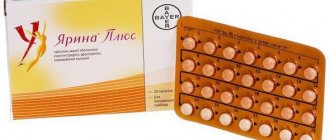Mirena is a hormonal intrauterine device (IUD) inserted into a woman's uterus to prevent pregnancy long-term. The device is T-shaped and releases a type of progestin called levonorgestrel. This thickens the cervical mucus, preventing sperm from fertilizing the egg. The IUD also partially suppresses ovulation and makes the uterine wall (endometrium) thinner.
According to the instructions, it is installed for up to 5 years, although it can remain effective for up to 7 years of continuous use. It is recommended primarily to all those who already have at least one child.
The Mirena brand is today the main hormonal intrauterine device (IUD) in the world, and the only one licensed both in the domestic market and approved by the Food and Drug Administration (FDA) in the USA.
Pharmacological properties of the drug Mirena
Levonorgestrel is a progestogen used in gynecology as a progestogen component in oral contraceptives and hormone replacement therapy or alone in progestogen-only oral contraceptives and in subdermal implants. Levonorgestrel can also be inserted into the uterus with intrauterine systems. This allows the use of very low doses of the drug, since the hormone is released directly into the organ. Mirena is characterized mainly by the local action of progestogen in the uterus. High concentrations of levonorgestrel in the endometrium reduce the function of endometrial estrogen and progesterone receptors, making the endometrium insensitive to circulating estradiol, and also have a pronounced antiproliferative effect. During the use of Mirena, morphological changes in the endometrium and a weak local reaction to a foreign object were noted. Thickening of cervical mucus prevents sperm from passing through the cervical canal. The local environment of the uterus and ovarian tubes suppresses sperm mobility and function, preventing fertilization. In some patients, ovulation is suppressed. Research into the contraceptive effectiveness of Mirena has been conducted primarily by comparing it with various copper intrauterine devices. They currently cover 13,000 women/year of Mirena use, with an overall pregnancy rate of 0.16 per 100 women/year. Using Mirena does not change future fertility. Approximately 80% of women who wanted to become pregnant became pregnant within 12 months after removal of the system. The menstrual pattern is the result of the direct action of levonorgestrel on the endometrium and does not reflect the ovulation cycle. There are no clear differences in the development of follicles, ovulation, or the production of estradiol and progesterone in women with different menstruation patterns. In the process of inactivation of endometrial proliferation in the initial phase of use during the first months, increased bleeding may occur. Over time, a strong inhibition of endometrial proliferation leads to a reduction in the duration and volume of menstrual bleeding during Mirena use. Light menstruation often turns into oligomenorrhea or amenorrhea. Even with amenorrhea, patients using Mirena have normal ovarian function and estradiol levels are maintained. Mirena can be successfully used in the treatment of idiopathic menorrhagia. In women with menorrhagia, the volume of menstrual bleeding was reduced by 88% after the 3rd month of using the system. Menorrhagia caused by submucosal fibroids may produce a less pronounced positive reaction. A decrease in menstruation leads to an increase in hemoglobin levels in the blood. Mirena also relieves dysmenorrhea. The effectiveness of Mirena in preventing endometrial hyperplasia during long-term estrogen treatment was equally high when estrogen was administered orally and transdermally. The incidence of hyperplasia during estrogen-only therapy is 20%. In clinical studies of Mirena involving 201 perimenopausal women and 259 postmenopausal women over 5 years of observation, not a single case of endometrial hyperplasia was recorded in the group of postmenopausal patients. After the introduction of Mirena, the initial release of levonorgestrel into the uterine cavity is 20 mcg/day. This ensures a constant level of levonorgestrel plasma concentration, which during the first weeks after administration is set at 0.4–0.6 nmol/l (150–200 pg/ml) in women of childbearing age and approximately 1 nmol/l (300 pkg/ml) in women receiving estrogen replacement therapy. After long-term use for 12, 24 and 60 months in young women, levonorgestrel plasma concentrations were determined to be 180±66 pkg/ml, 192±140 pkg/ml and 159±60 pkg/ml. In postmenopausal Mirena users, plasma levonorgestrel concentrations were 276±119 pkg/ml, 196±87 pkg/ml and 152±43 pkg/ml, respectively. Due to the low plasma levels of levonorgestrel, the systemic effect of the progestogen was minimized. Levonorgestrel, when administered orally, is rapidly and completely absorbed, its absolute bioavailability is about 90%. Levonorgestrel binds in the blood plasma to albumin and sex hormone binding globulin (SHBG). The relative distribution (free, albumin-bound and SHBG-bound) depends on the concentration of SHBG in the blood plasma. Only about 2.5% of the total drug in the blood plasma is found as a free steroid, but 47.5 and 50% are bound to SHBG and albumin, respectively. For levonorgestrel, the mean volume of distribution is approximately 137 L; the level of elimination of metabolites from blood plasma is about 5.7 l/h. The half-life of levonorgestrel is 14–20 hours after administration of a single dose. Levonorgestrel is excreted as metabolites in approximately equal parts with urine and feces. Metabolites are weakly or generally inactive pharmacologically. The main metabolite excreted in the urine is tetrahydronorgestrel, which accounts for about 10% of the total volume of all radioactive elements that are excreted in the urine after administration of radiolabeled levonorgestrel. About 0.1% of the dose of levonorgestrel a mother receives can be passed through breast milk to the baby during breastfeeding.
Composition and description
The Mirena intrauterine device not only protects against unwanted pregnancy, but also treats. It contains the hormonal substance levonorgestrel in the amount of 52 ml. The secondary component in the spiral is polydimethylsiloxane elastomer.
The appearance of the intrauterine therapeutic system resembles the letter “T”, placed in a special conductor tube, which has a white core and has an elastomeric hormonal filling. The spiral body is equipped with a loop on one side and two arms on the other. Threads are attached to the loop, with the help of which the spiral is removed from the vagina.
Use of the drug Mirena
Mirena is inserted into the uterine cavity and is effective for 5 years. The initial dissolution rate in vivo is 20 μg/day and after 5 years is reduced to 11 μg/day. The average dissolution rate of levonorgestrel over a five-year period is 14 mcg/day. Mirena is packaged in a sterile package that should not be opened until the system is installed. When handling the product out of packaging, you must adhere to aseptic precautions. If the protective layer of the packaging is torn, the intrauterine system should be discarded as medical waste. The removed system is also treated as medical waste because it may contain hormone residues. Specific instructions for administration are included in the package. Since the technique for inserting this system differs from the technique for inserting other intrauterine contraceptives, it is necessary to pay special attention to mastering the skills (techniques) for correct installation of the system.
Operating principle
The principle of operation of the spiral is as follows:
- the uterus reacts to the presence of levonorgestrel in the cavity;
- even a fertilized egg is not immersed in the uterine epithelium, since its functions are extremely weak;
- the natural growth of the endometrium is suspended, and the work of its glands is weakened;
- under the influence of contraception, the passage of sperm through the uterine tract becomes difficult;
- contraception can increase the viscosity of mucus, which impedes the passage of sperm;
- When placed, hormonal changes in the endometrium and shortening of the menstrual period are possible.
Contraindications to the use of Mirena
pregnancy (including suspected); pelvic inflammatory disease (or relapse); lower genital tract infections; postpartum endometritis; infected abortion within the last 3 months; cervicitis; cervical dysplasia; malignant tumors of the cervix or uterus; undiagnosed abnormal vaginal bleeding; congenital or acquired pathologies of the cervix or uterus, including fibrous tumors that deform the uterine cavity; conditions associated with increased susceptibility to infections; acute liver diseases or liver tumors; hypersensitivity to the components of the drug.
What do doctors say about the spiral?
The side effects of the Mirena spiral do not occur in all women, so many women not only use it to protect themselves from unwanted pregnancy, but are also treated. This is confirmed by experienced specialists. They often recommend the system to women who have heavy and painful periods. Gynecologists strongly recommend IUDs for fibroids and fibroids. According to them, this system is a real breakthrough in gynecology. It prevents endometrial hyperplasia and can be used in hormone replacement therapy.
As a rule, doctors are not surprised by the side effects that occur during the first time after insertion of the IUD. They react to them calmly and warn patients that this is normal, there is a period of adaptation and after the first menstruation with the IUD everything will go away.
Doctors say that the levonorgestrel contained in this spiral acts directly on the endometrial layer. Reduces its implantation ability, affects the reduction in the volume of menstruation and reduces its duration, and removes menstrual pain. Contraception is valid for five years, which is very convenient for many women.
According to doctors, it is not possible to immediately guess whether the IUD will suit a woman or not. Each woman tolerates the hormonal drug in her own way. But they warn that before installing the Mirena spiral, you should undergo a complete diagnosis in order to exclude the occurrence of various pathologies in the future. The spiral is not installed if malignant tumors are detected, with diseases of the liver organ, heart and bleeding, the cause of which is unclear.
Side effects of Mirena
They occur more often in the first months after the introduction of the system and their severity decreases over time. In addition to the side effects listed in the SPECIAL INSTRUCTIONS section, women using Mirena reported the following adverse events (although a causal relationship with Mirena could not always be confirmed):
- changes in the nature of menstruation and benign ovarian cysts (more than 10% of patients);
- changes in the nature of bleeding (frequent, prolonged or severe bleeding, spotting, oligomenorrhea, amenorrhea). In patients of childbearing age, the average number of bleeding days per month decreased gradually from 9 to 4 days during the first 6 months of use. The percentage of women with prolonged bleeding (more than 8 days) decreased from 20 to 3% in the first 3 months of use. In clinical studies, during the first year of use, 17% of women developed amenorrhea lasting at least 3 months;
- When using Mirena in combination with estrogen replacement therapy, the majority of patients in the peri- and postmenopausal period reported spotting and irregular bleeding during the first months of treatment. Over time, bleeding and spotting decreased and in almost 40% during the last 3 months of the first year of use, bleeding disappeared completely. In perimenopausal patients, menstrual bleeding disorders were observed more often than in postmenopausal patients.
The incidence of benign cysts depends on the diagnostic method used. In clinical trials, enlarged follicles were diagnosed in 12% of patients using Mirena. Most cases of increased follicle size were asymptomatic and disappeared within 3 months.
Organ system | Common side effects 1/100, ≤1/10 | Rare side effects 1/1000, ≤1/100 | Very rare side effects 1/10,000, ≤1/1000 |
| Infections | Genital infections | ||
| Endocrine system | Edema (peripheral or abdominal) | ||
| Metabolism and absorption of food | Weight gain | ||
| Psycho-emotional sphere | Depression, irritability, emotional lability | Decreased libido | |
| Nervous system | Headache | Migraine | |
| Gastrointestinal tract | Abdominal and/or pelvic pain, nausea | Bloating | |
| Skin and subcutaneous tissue | Acne | Hirsutism, hair loss, itchy skin | Rash, hives, eczema |
| Musculoskeletal system, connective tissue | Backache | ||
| Reproductive system. Mammary gland | Dysmenorrhea, vaginal discharge, cervicitis, feeling of tightness in the chest, mastalgia | Perforation of the uterus | |
| Local reaction to administration | Expulsion of the system |
Feedback from women is positive
The Mirena spiral has received both positive and negative reviews. Ladies who are satisfied with the use of the IUD note stabilization of the menstrual cycle, safe sex and long-term reliable contraception.
According to women's reviews, Mirena is not felt at all during sexual intercourse. According to them, the therapeutic system is simply a godsend for women with menorrhagia, endometrial hyperplasia, fibroids and fibroids.
Many patients report discomfort during the first month of IUD insertion. As a rule, these are pain in the abdomen and back, a sensation of a foreign body, and spotting. But, according to the ladies, after the first menstruation, these adverse reactions disappear and patients with the IUD feel much more comfortable.
Special instructions for the use of Mirena
The possibility of using the Mirena system should be carefully analyzed if the patient has any of the following conditions or if such symptoms occur for the first time while using Mirena (in these cases, the doctor may consider removing the system): migraine, focal migraine with asymmetric vision loss, or other symptoms , indicating transient cerebral ischemia; very severe headache; jaundice; increased blood pressure; confirmed or suspected hormone-dependent tumor, including breast cancer; arterial disease (stroke or myocardial infarction). In patients using oral contraceptives containing only progestogen, according to recent epidemiological studies, the risk of developing venous thromboembolism is increased, but the results of these studies are not statistically significant. It is necessary to carry out diagnosis and therapy when symptoms of thrombosis appear. Symptoms of venous or arterial thrombosis may include: unilateral leg pain and/or swelling; sharp severe pain in the chest, radiating or not radiating to the left arm; sudden shortness of breath; sudden cough; intense, prolonged headache; sudden partial or complete loss of vision; double vision; slurred speech or aphasia, vertigo; collapse (with or without focal epileptic seizure); weakness; numbness on one side of the body; impaired motor skills and severe abdominal pain. Symptoms indicating retinal vascular thrombosis: unexplained partial or complete loss of vision, onset of proptosis or papilledema, diplopia, retinal vascular damage. There is no consensus regarding the likely role of varicose veins and superficial vein thrombophlebitis in the development of venous thromboembolism. Mirena is used with caution in patients with congenital heart diseases, heart valve defects and there is a risk of developing endocarditis. Such patients should be treated with prophylactic antibiotics before insertion or removal of an intrauterine system. Low doses of levonorgestrel may affect glucose tolerance, so blood glucose concentrations should be monitored in diabetic patients using Mirena. Irregular bleeding may mask symptoms and signs of endometrial polyps or cancer, in which case diagnostic testing should be considered. Mirena is not the first choice for young patients who have not had pregnancies or for postmenopausal patients with severe uterine atrophy. Insertion and removal/replacement Before insertion of the intrauterine system, the patient must be informed about the effectiveness, risks and side effects of Mirena. A physical examination of the patient should be performed, including a pelvic examination, breast examination, and a cervical smear. It is necessary to exclude pregnancy and sexually transmitted diseases, and treat infectious diseases of the pelvic organs. It is necessary to determine the location of the uterus and the size of the uterine cavity. It is especially important to place Mirena in the fundus of the uterus to ensure the same effect of progestogen on the entire surface of the endometrium. This prevents expulsion and allows maximum efficiency to be achieved. The patient should visit the doctor 4-12 weeks after the system is inserted and after a year (or more often if there is a medical indication for this). For patients of childbearing age, Mirena is administered into the uterine cavity within 7 days from the start of menstruation. You can replace the Mirena system with a new one at any time during the menstrual cycle. The system can also be administered immediately after an abortion if it is performed in the first trimester of pregnancy. Postpartum administration - 6 weeks after birth. Mirena cannot be used as a postcoital contraceptive. When Mirena is used to protect the endometrium during estrogen replacement therapy, it can be administered to amenorrheic patients at any time or during the last days of menstruation. In the first months of therapy, irregular bleeding/spotting is often noted, therefore, before introducing Mirena, it is recommended to exclude endometrial pathology. If the patient continues to use the Mirena system, which was previously introduced for the purpose of contraception, it is necessary to exclude endometrial pathology in the event of abnormal bleeding after prescribing estrogen replacement therapy. If irregular bleeding occurs during prolonged use of the system, appropriate diagnostics must be carried out. The Mirena is removed by gently pulling the threads with surgical tweezers. If the threads are invisible and the system is in the uterine cavity, it can be removed using a narrow, sharp surgical clamp. To do this, it may be necessary to dilate the cervical canal. The system must be removed after 5 years. If the patient wishes to continue using this method, a new system can be introduced immediately. If pregnancy is not desired, women of childbearing age should have the system removed during menstruation (if there is a menstrual cycle). If the system is removed in the middle of the menstrual cycle and the patient has had sexual intercourse during the previous week, there may be a possibility of pregnancy if the old system is not replaced with a new one when removed. Insertion and removal of the system may cause pain and bleeding; dizziness as a vasovaginal reaction; seizure in patients with epilepsy. Oligoamenorrhea Among patients of childbearing age who used Mirena, 20% gradually developed oligomenorrhea and/or amenorrhea. If a woman does not have a new period 6 weeks after her last menstruation, she needs to take a pregnancy test. A second pregnancy test should not be performed in amenorrheic women unless other symptoms of pregnancy are noted. When using Mirena in combination with constant estrogen replacement therapy, most women experience a gradual disappearance of menstruation during the first year. Infectious diseases of the pelvic organs The tube for introducing the system prevents contamination of the system by microorganisms during the insertion process and minimizes the risk of infection. In patients using copper intrauterine systems, a very high level of development of infectious diseases of the pelvic organs was noted during the first month after insertion; over time, the level of diseases decreased. Several studies suggest that the incidence of pelvic infections is lower in patients using Mirena than in patients using copper intrauterine devices. It has been proven that a risk factor for the development of inflammatory diseases of the pelvic organs is the presence of several sexual partners in a woman. Pelvic infections can affect fertility and increase the risk of ectopic pregnancy. If a recurrence of endometritis or severe acute inflammation or an acute infection that has not been treated for several days is noted, Mirena must be removed. It is necessary to conduct bacteriological studies and monitor the patient even if there are only some symptoms of infection. Expulsion Symptoms of partial or complete expulsion of any intrauterine device: pain and abnormal bleeding. However, the system can leave the uterine cavity unnoticed by the woman. Partial loss of Mirena from the uterus reduces its effectiveness. Since Mirena reduces the amount of menstrual flow, increased flow may be a sign of expulsion. If Mirena has moved, it must be removed. At the same time, a new system can be introduced. The patient should be advised how to check for the presence of Mirena threads. Perforation In very rare cases (usually during insertion), the IUD may penetrate or puncture the wall of the uterus or cervix. Such a system must be removed. Ectopic pregnancy Patients with a history of ectopic pregnancy, tubal surgery, or genital infections have an increased risk of ectopic pregnancy. The possibility of developing an ectopic pregnancy must be excluded if pain occurs in the lower abdomen, especially in the absence of menstruation or if bleeding occurs in a woman with amenorrhea. The incidence of ectopic pregnancy when using Mirena is 0.06 per 100 women/year. This rate is lower than the rate of 0.3–0.5 per 100 women/year calculated for patients using no contraception at all. Missing threads If during the next examination the removal threads are visually absent from the cervix, then pregnancy must be excluded. The threads may have entered the uterus or cervix and may reappear during your next period. If pregnancy is excluded, the location of the threads can be determined by careful probing with an appropriate instrument. If threads cannot be found, the system may have failed. To ensure the correct location of the system, you can use ultrasound diagnostics. If an ultrasound examination is not possible or does not provide the desired results, an x-ray examination can be performed to determine the placement of Mirena. Delayed follicular atresia Since the contraceptive effect of Mirena is associated with local action, ovulation cycles with follicular rupture usually occur in patients of childbearing age. Sometimes follicular atresia is delayed and follicular development may continue. Such enlarged follicles cannot be clinically distinguished from ovarian cysts. Enlarged follicles were diagnosed in 12% of patients using Mirena. Most of these follicles are asymptomatic, although some may be accompanied by abdominal pain or dyspareunia. In most cases, enlarged follicles disappeared spontaneously within 2–3 months of observation. If this does not happen, regular ultrasound examinations or other diagnostic/therapeutic procedures are recommended. In rare cases, surgery is required. Pregnancy Mirena is not used during pregnancy or if pregnancy is suspected. If pregnancy occurs while the Mirena system is in place, it is recommended to remove the system, since any intrauterine contraceptive device that remains in the uterus during pregnancy increases the risk of miscarriage and premature birth. Removing Mirena or palpating the uterus can lead to spontaneous abortion. If it was not possible to carefully pull out the system, the issue of abortion must be resolved. If the patient wishes to continue the pregnancy and it is not possible to remove the system, she should be informed about the risk of preterm birth and the consequences of preterm birth for the baby. The course of such a pregnancy requires constant monitoring. It is necessary to exclude ectopic pregnancy. The doctor should advise the woman to inform him of any symptoms that may be associated with pregnancy complications, such as paroxysmal abdominal pain accompanied by fever. Due to intrauterine administration and local action of the hormone, teratogenicity (especially virilization) cannot be completely excluded. The drug has high contraceptive effectiveness, so clinical experience with the results of pregnancy with the Mirena system is limited (however, the patient should be informed that there are currently no cases of birth defects in children associated with the use of Mirena by mothers in cases where pregnancy developed with the Mirena system installed) . During breastfeeding, Levonorgestrel passes into breast milk, but the risk of the dose of the drug released from Mirena affecting the baby is unlikely.
No undesirable effects on the growth and development of the child were detected when using only progestogen 6 weeks after birth. Progestogen-only methods have demonstrated no effect on the quantity or quality of breast milk. Cases of uterine bleeding during lactation are rare. The effect on the ability to drive vehicles or operate machinery is not known.
Negative opinion about the spiral
The Mirena hormonal device has also earned negative reviews. Side effects after its installation occur in almost everyone. It’s just that for some they go away after a month, while others are bothered by a longer period, and they have to remove the spiral.
Among the side effects, users note severe weight gain, swelling, skin rashes, pain in the lower abdomen and back, sudden jumps in blood pressure, loss of sexual desire, and regular spotting. Some patients, after the introduction of the Mirena spiral, felt depression, constant nervousness and bad mood. They were worried about weakness, irritation and mood swings. There are those for whom this therapeutic system provoked the formation of a tumor, ovarian cysts, varicose veins and hair loss.
Some women claim that after removing the IUD, they were bothered by heavy periods that lasted continuously for about a month. There are those who immediately felt better after removing the IUD. These patients' mental state normalized, pain disappeared, and menstruation stabilized.
Why is it used during menopause?
The spiral is recommended for normalizing the endometrium during natural menopause, as well as after removal of the ovaries. Thanks to this tool:
- bleeding stops;
- the level of hemoglobin and red blood cells in the blood is normalized;
- the growth of the endometrium and the risk of tumor processes are prevented;
- pain in the lower abdomen decreases.
The Mirena spiral prevents the growth of the endometrium
Probability of pregnancy
When Mirena is installed correctly, the Pearl index (an indicator reflecting the number of pregnancies in 100 women using contraceptives during the year) is about 0.2%. The overall rate, which reflects the number of pregnancies in 100 women using contraception for 5 years, is 0.7%.
What to do if conception occurs
If a woman with Mirena installed becomes pregnant, the risk of spontaneous abortion and premature birth increases. It is recommended to remove the IUD.
Removing the system can also lead to miscarriage. If it is not possible to carefully remove the contraceptive, then the feasibility and necessity of a medical abortion according to indications should be discussed.
If a woman wants to continue her pregnancy, then the patient should be fully informed about the possible risks and consequences for her body and the body of the child. In the future, such a pregnancy requires careful monitoring. It is imperative to exclude ectopic implantation (ectopic).
Due to the topical use of hormonal contraceptives, there is a possibility of hormonal effects on the fetus. However, due to the high effectiveness of the pharmaceutical drug Mirena, there is very little research on this topic. And clinical experience in managing such pregnancies is very limited. The woman who wishes to keep the child should also be informed about this.
How it works
The active substance of the spiral belongs to gestagens. Hormone:
- blocks the growth of the endometrium;
- prevents cancer cells from multiplying;
- normalizes the balance between estrogen and progesterone;
- does not affect the normal functioning of the ovaries;
- blocks the appearance of pathologies of the pelvic organs;
- reduces the symptoms of menopause;
- protects against unwanted conception;
- acts as an excellent means of preventing the growth of the endometrium during menopause and endometriosis.
After installing the system, the woman’s body receives a certain dose of levonorgestrel (20 mcg) every day. By the end of the five-year period of use, this figure drops to 10 mcg per day. It is important to note that almost the entire dose of the hormone is concentrated in the endometrium, and the hormone content in the blood does not exceed a microdose.
The active substance does not begin to enter the blood immediately. This happens in about an hour, and after 14 days the blood contains the highest concentration of levonorgestrel, but this figure depends on the woman’s weight. If a woman weighs no more than 54 kilograms, then this figure will be 1.5 times more.
According to reviews, after installation of the system, unstable spotting discharge may be observed, but only during the first few months. This is due to the restructuring of the endometrium, after which the duration and volume of bleeding is significantly reduced. And sometimes they stop altogether.
Is it possible to install or remove it yourself?
As we have already discussed, installation is carried out only by a gynecologist. Removal of the IUD is also carried out only by a doctor, since removing it yourself can damage the mucous membrane of the genital organs. And this can lead to negative consequences (for example, infection). Removal is performed during menstruation, after a gynecological examination. The doctor removes the coil by pulling the antennae. Removing the IUD does not cause significant discomfort or pain.
There are both direct indications for removal and the woman’s own desire.
The IUD must be removed in the following conditions:
- expiration date of the spiral;
- inflammation of the uterine appendages;
- fibroid growth or its primary occurrence;
- spiral loss;
- conceiving a child.
Installation and removal of the IUD may be accompanied by some pain and bleeding, so the woman should be under the supervision of a doctor.










